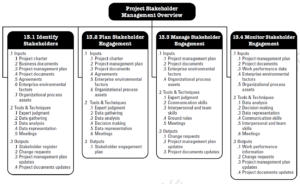
When Airbus faced delays in delivering the A380 Superjumbo in 2005 and 2006, software glitches weren’t the only fallout. The second delay tanked the share price by 26% and cost executives their jobs.
This high-stakes saga reveals a core truth of project management: even a flawlessly executed plan falls short if the stakeholders aren’t satisfied.
But who exactly are these stakeholders, and why do they hold such sway over a project’s success? Let’s unpack their critical role and influence.
What are Project Stakeholders?
Simply put, a stakeholder is anyone who has an interest in the project. They can be a person or company, a customer or a sponsor, an affected party or a project cheerleader – It does not matter. Anyone who has a “stake” in the project is a stakeholder. For example,
- A landowner beside a new highway construction project
- An employee who needs the project in order to keep her job
- A supplier who needs the project’s expenditures to remain in business
The project manager must know who the stakeholders are and actively manage their participation in the project. If not, stakeholders have the ability to trip up the successful delivery of the project.
 Stakeholders have expectations. Just like the customers of the Airbus A380 expected a finished airplane to be delivered on a certain date, so also do small projects have stakeholders who expect various things. Most stakeholders do not have day to day involvement in the project (except for the project team) but they have an interest in the project and have informational needs.
Stakeholders have expectations. Just like the customers of the Airbus A380 expected a finished airplane to be delivered on a certain date, so also do small projects have stakeholders who expect various things. Most stakeholders do not have day to day involvement in the project (except for the project team) but they have an interest in the project and have informational needs.
Types of Project Stakeholders
Stakeholders fall into the following five categories:
- Project Sponsor: The organizational contact person who accepts the project’s deliverables.
- Project Manager: The person responsible to create a successful project.
- Project Team: The people who carry out the day to day work of the project.
- Customers: The end users of the product or service the project is producing, for example the customers of the Airbus A380.
- Passive Stakeholders: Other users that are affected by a project, such as adjacent landowners, regulatory agencies, and environmental NGO’s.
In addition, stakeholders can fall anywhere on the supportive-resistant continuum:
- Unaware: Oblivious to the potential impacts of the project
- Resistant: Aware of potential project impacts but in opposition to the project
- Neutral: Aware of the project but neither supportive nor opposed
- Supportive: Aware of the project and supportive of it
- Leading: Aware of the project and actively engaged in its success
Project Stakeholder Management
 Stakeholder management is a knowledge area within the Project Management Body of Knowledge (PMBOK). It contains four processes:
Stakeholder management is a knowledge area within the Project Management Body of Knowledge (PMBOK). It contains four processes:
- Identify Stakeholders: It’s surprisingly easy to forget about someone who has a minor or passive interest in the project, and it’s amazing how quickly these stakeholders can make a project go south. A Stakeholder Register lists each stakeholder and analyzes their needs.
- Plan Stakeholder Engagement: Active planning of stakeholder communication is an element that could have saved many a project from the doghouse. The regular communication needs of each stakeholder are analyzed and documented.
- Manage Stakeholder Engagement: From regular emails and status updates to open houses, meetings to coffee shop get-togethers, the engagement of stakeholders separates good project managers from bad.
- Monitor Stakeholder Engagement: This represents the methodical process of continually monitoring stakeholder engagement and determining if it is satisfying the needs of the stakeholders.
The Stakeholder Register
Core to the process is a document called the Stakeholder Register. It identifies the stakeholders and analyzes their needs. It contains the following information (PMBOK 13.1.3.1):
- Identification Information: The basics – Who they are and how they can be contacted.
- Classification: Stakeholders can be analyzed in several ways:
- Impact/Influence/Power/Interest attempts to itemize their level of determine how much damage each stakeholder can inflict on the project.
- Up/Down/Out/Sideways classifies each stakeholder into whether they are on your side, against you, passive, or collaborative.
- Assessment Information: The stakeholder’s expectations, as well as what actions to take in order to manage them.
From writing a school report to building the world’s largest airplane, the proactive management of stakeholders is a necessity to producing successful projects.
Good luck!











Leave a Reply